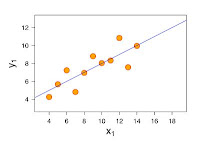 |
| Correlation |
This was a cross-sectional study that looked at the correlation between statistically representative samples of Medicare beneficiaries' 2007 costs,deaths and preventable hospitalizations vs. the density of primary care physicians within zip-code assigned "primary care service areas." There were two measures of primary care density: 1) the AMA "Master File" which uses mail physician survey data to count the type and location of doctors (the DMCB remembers completing these surveys), and 2) an estimate of 'full time equivalents" (FTEs) practicing primary care that was inferred from the types and numbers of claims submitted to Medicare.
After controlling for known statistical sources of bias in the service areas, the authors found that the number of "physicians" were lower than the number of "FTEs." Across service areas, the former ranged from 17 to 81 per 100,000 beneficiaries, while the latter ranged from 65 to 103 per 100,000. There also appeared to be low correlation between the physician and FTE measures, suggesting that there were many physicians who were not self-identified as primary care but were still providing primary care services.
The authors then sorted the service areas into physician and FTE quintiles, ranging from high to low. Expecting to find progressively lower hospitalization rates, deaths and costs among the higher quintiles, the authors instead found:
Death rates (overall about 5.4%) did not meaningfully vary across the physician quintiles but dropped slightly among the FTE quintiles,
Preventable hospitalizations (ranging from 75 to 80 per thousand) were weakly correlated in that the highest quintile beat the lowest by 5 to 8 points for physicians and FTEs, respectively,
Costs seemed flat (around $8700 per beneficiary) across the physician quintiles but were elevated (about $8850 per beneficiary) in the highest FTE quintile. That trend, however, did not achieve statistical significance.
While the authors' study was complicated by having to reconcile two measures (doctors and "FTEs") of primary care physicians, they ultimately found only a modest correlation with primary care and lower mortality and hospitalizations, but higher spending. The conclusions were stronger when they counted FTEs vs. physicians. Things can be nicely summed up in this quote:
"If all areas' primary care FTEs (in the United States) increased to the highest quintile, the model suggests that this might lead to 48 398 fewer deaths and 436 002 fewer hospitalizations, but would cost $13.8 billion more in total Medicare program spending. The higher spending is from more spending in clinician spending (Part B, $36.4 million more) that is more than the reduction from lower spending in acute care facilities (Part A, $22.6 million less)."
Disappointed? So is the DMCB but it's not all that surprised. It's suspected for quite some time that the impact of primary care physicians on health care utilization is somewhat limited. In looking at the actual numbers in the Tables of the JAMA study, death rates are varying by decimal points and the shift in costs per beneficiary is in the range of about a hundred dollars. Primary care is hardly the solution to the twin U.S. health care challenges of costs and quality.
It's also important to note that this paper is all about association, not causality. Based on this study alone, the DMCB cannot conclude that moving primary care physicians from high to low density service areas will cause costs to go up or death rates to go down. That can be implied, but it's also possible that primary care physicians prefer to practice in areas that with spending patterns that translate into higher incomes.
That being said, this is worrisome for Accountable Care Organizations, which are supposed to secure an adequate base of primary care physicians. Based on a potential cost differential of $100 per beneficiary, this suggests having a high number of PCPs in the ACO network could increase costs and hamper the ability of these organizations to obtain the upside gainshare.












5 comments:
Clarification question. The following quote in this entry either uses millions where billions should be or billions where millions. I presume you meant billions.
"If all areas' primary care FTEs (in the United States) increased to the highest quintile, the model suggests that this might lead to 48 398 fewer deaths and 436 002 fewer hospitalizations, but would cost $13.8 billion more in total Medicare program spending. The higher spending is from more spending in clinician spending (Part B, $36.4 million more) that is more than the reduction from lower spending in acute care facilities (Part A, $22.6 million less)."
Good point. The quote below is word for word. I'll email the authors.....
The DMCB emailed the authors:
--- "Jaan Sidorov" wrote:
Congrats on your publication in JAMA. I'm a blogger and reviewed the article in my blog.
One astute DMCB reader wondered about the following quote from your manuscript:
"If all areas' primary care FTEs (in the United States) increased to the highest quintile, the model suggests that this might lead to 48 398 fewer deaths and 436
002 fewer hospitalizations, but would cost $13.8 billion more in total Medicare program spending. The higher spending is from more spending in clinician spending (Part B, $36.4 million more) that is more than the reduction from lower spending in acute care facilities (Part A, $22.6 million less)."
He asks if it's billions or millions or both?
(either way, in this day of outsized budgets, either could be some sort of rounding error, but I digress......)
Thanks!
Jaan
Reply:
Thank you for the correction.
It should be BILLION, not million.
Chiang-Hua
I wonder if the FTE's not self identifying as primary care providers are trained in nonprimary care specialties and skewing the utilization curve?
Good point: "non" PCPs account for the high costs. That being said, it still looks like primary care is NOT a money-saving no-brainer.
Post a Comment